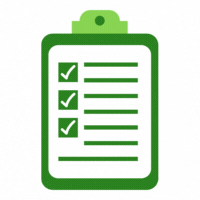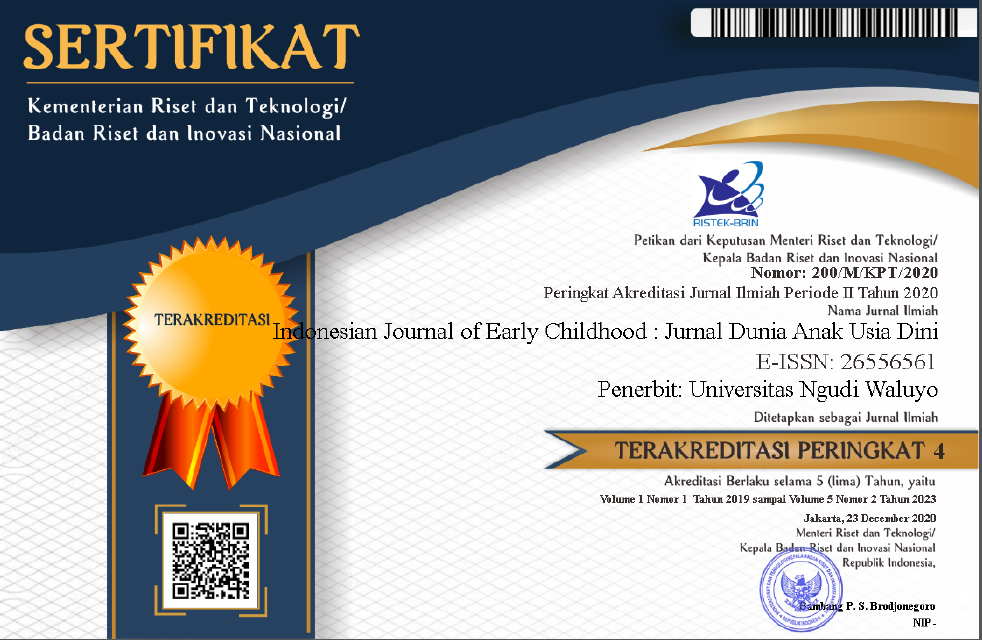Kurikulum Pendidikan Agama Islam Indonesian untuk Anak Usia Dini
Indonesian Islamic Religious Education Curriculum for Early Childhood
DOI:
https://doi.org/10.35473/ijec.v7i1.3485Keywords:
kurikulum, anak usia dini, Pendidikan Agama IslamAbstract
The purpose of this study was to determine the curriculum of Islamic religious education for Early Childhood. This study was conducted using the Systematic Literature Review (SLR) method. The articles used were sourced from the Sinta database assisted by Connected Papers with a span of 2015-2024. The results of the study indicate that the curriculum of Islamic religious education for early childhood in its concept emphasizes thematic, integral-holistic and oriented curriculum on daily life and is centered on students. The curriculum material includes an introduction to the Creator and His creation, ablution, reading Asma'ul Husna, reading daily prayers and morals. The learning method is based on science and thematics that unite beliefs, worship, and morals as well as the habituation of worship practices and the practice of reading the Qur'an through the Iqra' method.
ABSTRAK
Tujuan dari penelitian ini adalah untuk mengetahui kurikulum pendidikan agama Islam untuk Anak Usia Dini. Penelitian ini dilakukan dengan menggunakan metode Systematic Literature Review (SLR). Artikel yang digunakan bersumber dari database Sinta yang dibantu oleh Connected Papers dengan rentang 2015-2024. Hasil penelitian menunjukkan bahwa kurikulum PAI anak usia dini dalam konsepnya menekankan kurikulum tematik, integral-holistik dan berorientasi pada kehidupan sehari-hari serta berpusat pada siswa. Materi kurikulum meliputi pengantar Sang Pencipta dan ciptaan-Nya, wudhu, membaca Asma'ul Husna, membaca doa sehari-hari dan akhlak. Metode pembelajaran berbasis ilmiah dan tematik yang menyatukan keyakinan, ibadah, dan moral serta pembiasaan praktik ibadah dan praktik membaca Al-Qur'an melalui metode Iqra'.
References
Akrim, A., & Junaidi. (2021). A study of the role of religious development in childhood on psychological health in Indonesia. HTS Teologiese Studies / Theological Studies, 77(4). https://doi.org/10.4102/hts.v77i4.6584
Aslan, E. (2020). Preface. In E. Aslan (Ed.), Migration, Religion and Early Childhood Education (p. 270). Springer Fachmedien Wiesbaden. https://doi.org/10.1007/978-3-658-29809-8
Bartkowski, J. P., Xu, X., & Levin, M. L. (2008). Religion and child development: Evidence from the Early Childhood Longitudinal Study. Social Science Research, 37(1), 18–36. https://doi.org/10.1016/j.ssresearch.2007.02.001
Byrne, C. (2014). Religion in Secular Education What, in Heaven’s Name, are we Teaching our Children? Brill.
Calderón, A., & Ruiz, M. (2015). A systematic literature review on serious games evaluation: An application to software project management. Computers & Education, 87, 396–422. https://doi.org/10.1016/j.compedu.2015.07.011
Elihami, E. (2021). Early Childhood Education with an Islamic Religious Education Approach in the Era of Community Challenges 5.0: Bibliometrics of Analysis of the term “Islamic Education and Early Childhood Education.” Mahaguru: Jurnal Pendidikan Guru Sekolah Dasar, 2(1), 6. https://ummaspul.e-journal.id/MGR/article/download/2197/711/
Fan, M. (2024). Early Childhood Education Curriculum Reform in China. International Journal of Education and Humanities, 15(1), 194–199. https://doi.org/10.54097/wyvdbj05
Farisia, H. (2020). Nurturing Religious and Moral Values at Early Childhood Education. Didaktika Religia, 8(1), 1–27. https://doi.org/10.30762/didaktika.v8i1.1881
Insiyah, M., & Suyadi, S. (2017). Development Analysis Religion in Early Age Children in RA DWP UIN Sunan Kalijaga Yogyakarta. Kaunia: Integration and Interconnection Islam and Science Journal, 13(2), 4. https://ejournal.uin-suka.ac.id/saintek/kaunia/article/view/1320
Jasuri. (2015). Pembelajaran Pendidikan Agama Islam pada Anak Usia Dini. Madaniyah, 5(1), 16–31. https://www.neliti.com/id/publications/195070/pembelajaran-pendidikan-agama-islam-pada-anak-usia-dini#cite
Jura, D., & Naray, C. L. N. (2023). Maximizing the Role of Parents Through Religious Education in the Family in the Scope of Early Childhood Education. AL-ISHLAH: Jurnal Pendidikan, 15(4), 5328–5336. https://doi.org/10.35445/alishlah.v15i4.4508
Kemendikbud. (2023, April). Pentingnya Menghidupkan Kembali Tripusat Pendidikan di Lingkungan Sekolah. Jendela Pendidikan Dan Kebudayaan.
Kitchenham, B., & Brereton, P. (2013). A systematic review of systematic review process research in software engineering. Information and Software Technology, 55(12), 2049–2075. https://doi.org/10.1016/j.infsof.2013.07.010
Kitchenham, B., Brereton, P., Zhi Li, Budgen, D., & Burn, A. (2011). Repeatability of systematic literature reviews. 15th Annual Conference on Evaluation & Assessment in Software Engineering (EASE 2011), 2011(1), 46–55. https://doi.org/10.1049/ic.2011.0006
Kuusisto, A. (2022). The Routledge International Handbook of the Place of Religion in Early Childhood Education and Care. Routledge. https://doi.org/10.4324/9781003017783
Mastiyah, I. (2014). Kurikulum Pendidikan Agama Islam Pada Raudhatul Athfal Dian Al-Mastiyah. EDUKASI: Jurnal Penelitian Pendidikan Agama Dan Keagamaan, 12(2), 261–274. https://doi.org/10.32729/edukasi.v12i2.87
Muthmainnah, M. (2015). Kurikulum Pendidikan Agama Islam Taman Kanak-Kanak Islam Terpadu (TKIT) Al-Azhar Lamgugob Banda Aceh. Bunayya : Jurnal Pendidikan Anak, 1(2), 19. https://doi.org/10.22373/bunayya.v1i2.1321
Mutholingah, S. (2024). Tinjauan Teoritis Kurikulum Pendidikan Agama Islam untuk Anak Usia Dini. AJMIE: Alhikam Journal of Multidisciplinary Islamic Education, 5(1), 108–126. https://doi.org/10.32478/wqg69r69
Neneng, N., Qomariyah, S., Rizki, N. J., Erviana, R., & Babullah, R. (2023). Konsep Pembelajaran Pendidikan Agama Islam (PAI) Pada Anak Usia Dini Di Kelompok Bermain Almuhajirin Perum Baros Kencana Kota Sukabumi. Khirani: Jurnal Pendidikan Anak Usia Dini, 1(3), 35–45. https://doi.org/10.47861/khirani.v1i3.359
Nurhalimah, E., Nurlaela, Isroani, F., Khumaini, F., & Ahmad Manshur. (2024). Implementasi PAI Multidisipliner Pada PAUD dan SD. AL-AFKAR : Journal for Islamic Studies, 7(2), 1220–1231. https://doi.org/https://doi.org/10.31943/afkarjournal.v7i2.1265
Paloutzian, R. F. (2016). Invitation to the psychology of religion. The Guilford Press.
Petticrew, M., & Roberts, H. (2006). Systematic Reviews in the Social Sciences A Practical Guide. Blackwell Publishing. http://www.blackwellpublishing.com/
Pew Research Center. (2008). Pew forum on religion and public life: U.S. Religious Landscape Survey. Pew Forum on Religion & Public Life. https://www.pewforum.org/wp-content/uploads/sites/7/2008/06/report2-religious-landscape-study-full.pdf
Setiawan, R., Saukotta, D. F., Risakotta, M. L., & Tanasyah, Y. (2024). Christian Religious Education Strategies for Early Childhood in Fostering Knowledge of God in Schools. Journal of Religious and Socio-Cultural, 4(2), 146–160. https://doi.org/10.46362/jrsc.v4i2.209
Slicker, G., Hustedt, J. T., & Stoffers, M. (2023). Participation of early care and education centers in the child care subsidy system: A statewide mixed methods investigation. Early Childhood Research Quarterly, 65, 317–331. https://doi.org/10.1016/j.ecresq.2023.07.009
Snyder, H. (2019). Literature review as a research methodology: An overview and guidelines. Journal of Business Research, 104, 333–339. https://doi.org/10.1016/j.jbusres.2019.07.039
Spodek, B., & Saracho, O. N. (1999). The Relationship Between Theories of Child Development and the Early Childhood Curriculum. Early Child Development and Care, 152(1), 1–15. https://doi.org/10.1080/0300443991520101
Sturgeon, J. (2022). Building the Foundation: The Benefits of Integrating Faith-Based Routines in Early Childhood Education. Northwestern College Stand Out.
Tannebaum, R. P. (2018). Teaching about religion within early childhood and elementary social studies: Exploring how preservice teachers perceive their rights and responsibilities as educators. Journal of Social Studies Education Research, 9(4), 30–48. https://doi.org/10.17499/jsser.63838
Undang Undang Sistem Pendidikan Nasional, 57 (2003).
Van Niekerk, M., & Breed, G. (2018). The role of parents in the development of faith from birth to seven years of age. HTS Teologiese Studies / Theological Studies, 74(1), 1–11. https://doi.org/10.4102/hts.v74i2.4773
Viliamu, K. L. (2021). The Effectiveness of the Thematic Approach for Teaching Young Children. Journal of Samoan Studies, 11(2). https://journalofsamoanstudies.ws/2021/10/30/the-effectiveness-of-the-thematic-approach-for-teaching-young-children/
Wahyuni, I. W., & Madjid, A. (2022). Islamic Religious Education Learning For Early Childhood in the Covid-19 Period. Jurnal Obsesi : Jurnal Pendidikan Anak Usia Dini, 6(5), 4471–4478. https://doi.org/10.31004/obsesi.v6i5.1799
Wantini, W., & Suyatno, S. (2019). Early Childhood Interpretation on Religion. The European Educational Researcher, 2(1), 35–48. https://doi.org/10.31757/euer.213
Wati, S., Amelia, R., Hidayatina, H., & Gusmirawati, G. (2022). Religious development and child personality: What does religious psychology say about them. Gender Equality: International Journal of Child and Gender Studies, 8(1), 109. https://doi.org/10.22373/equality.v8i1.12767
Widiyawati, R., Edwita, & Sumadi, T. (2023). Addressing Diversity Through Religious Education In The Early Childhood Education Curriculum (Case Studies in Early Childhood Institutions). Scientia, 2(2), 137–142. https://doi.org/10.51773/sssh.v2i2.241
Wood, E., & Hedges, H. (2016). Curriculum in early childhood education: critical questions about content, coherence, and control. The Curriculum Journal, 27(3), 387–405. https://doi.org/10.1080/09585176.2015.1129981
Downloads
Published
How to Cite
Issue
Section
License
Copyright (c) 2025 Indonesian Journal of Early Childhood: Jurnal Dunia Anak Usia Dini

This work is licensed under a Creative Commons Attribution-ShareAlike 4.0 International License.
Please find the rights and licenses in Indonesian Journal Of Early Childhood: Jurnal Dunia Anak Usia DIni. By submitting the article/manuscript of the article, the author(s) agree with this policy. No specific document sign-off is required.
1. License
The non-commercial use of the article will be governed by the Creative Commons Attribution license as currently displayed on Creative Commons Attribution-ShareAlike 4.0 International License.
2. Author(s)' Warranties
The author warrants that the article is original, written by stated author(s), has not been published before, contains no unlawful statements, does not infringe the rights of others, is subject to copyright that is vested exclusively in the author and free of any third party rights, and that any necessary written permissions to quote from other sources have been obtained by the author(s).
3. User Rights
Indonesian Journal Of Early Childhood: Jurnal Dunia Anak Usia Dini's spirit is to disseminate articles published are as free as possible. Under the Creative Commons license, Indonesian Journal Of Early Childhood: Jurnal Dunia Anak Usia Dini permits users to copy, distribute, display, and perform the work for non-commercial purposes only. Users will also need to attribute authors and Indonesian Journal Of Early Childhood: Jurnal Dunia Anak Usia Dini on distributing works in the journal and other media of publications.
4. Co-Authorship
If the article was jointly prepared by more than one author, any authors submitting the manuscript warrants that he/she has been authorized by all co-authors to be agreed on this copyright and license notice (agreement) on their behalf, and agrees to inform his/her co-authors of the terms of this policy. Indonesian Journal Of Early Childhood: Jurnal Dunia Anak Usia Dini will not be held liable for anything that may arise due to the author(s) internal dispute. Indonesian Journal Of Early Childhood: Jurnal Dunia Anak Usia Dini will only communicate with the corresponding author.
5. Miscellaneous
Indonesian Journal Of Early Childhood: Jurnal Dunia Anak Usia Dini will publish the article (or have it published) in the journal if the article’s editorial process is successfully completed. Indonesian Journal Of Early Childhood: Jurnal Dunia Anak Usia Dini's editors may modify the article to a style of punctuation, spelling, capitalization, referencing and usage that deems appropriate. The author acknowledges that the article may be published so that it will be publicly accessible and such access will be free of charge for the readers as mentioned in point 3.
Â
Every accepted manuscript should be accompanied by "Copyright Transfer Agreement" prior to the article publication.



